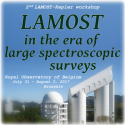Speaker
Dr
Anbing Ren
(Beijing Normal University)
Description
All of the 14 subfields of the Kepler field have been observed at least
once with the Large Sky Area Multi-Object Fiber Spectroscopic Telescope
(LAMOST, Xinglong Observatory, China) during the 2012-2014 observation
seasons. There are 88,628 reduced spectra with SNR$g$ (signal-to-noise ratio in $g$ band) ≥ 6 in the database of the LAMOST-Kepler project (LK-project). By adopting the upgraded version of the LAMOST Stellar Parameter pipeline (LASP), we have determined the atmospheric parameters (Teff, log $g$, and [Fe/H]) and heliocentric radial velocity vrad for 51,406 stars with 61,226 spectra. Compared with atmospheric parameters derived from both high-resolution spectroscopy and asteroseismology method for common stars in Huber et al. (2014), an external calibration of LASP atmospheric parameters was made, leading to the determination of external errors for the giants and dwarfs, respectively. Multiple spectroscopic observations for the same objects were used to estimate the internal uncertainties of the atmospheric parameters as a function of SNRg with the unbiased estimation method. The LASP atmospheric parameters were calibrated based on both the external and internal uncertainties for the giants and dwarfs, respectively. A general statistical analysis of the stellar parameters leads to discovery of 106 candidate metal-poor stars, 9 candidate very metal-poor stars, and 18 candidate high-velocity stars. Fitting formulae were obtained segmentally for both the calibrated atmospheric parameters of the LK-project and the KIC parameters with the common stars. The calibrated atmospheric parameters and radial velocities of the LK-project will be useful for studying stars in the Kepler field.
Primary authors
Dr
Anbing Ren
(Beijing Normal University)
Prof.
JIANNING FU
(BEIJING NORMAL UNIVESITY)
Dr
Peter De Cat
(Royal Observatory of Belgium)
Co-authors
Prof.
Ali Luo
(National Astronomical Observatories, Chinese Academy of Scienes)
Dr
Bing Du
(National Astronomical Observatories, Chinese Academy of Sciences)
Dr
Haotong Zhang
(National Astronomical observatories of China, CAS)
Prof.
Jianrong Shi
(National Astronomical Observatories, Chinese Academy of Sciences)
Ms
Ruyuan Zhang
(Beijing Normal University)
Dr
Subo Dong
(Peking University)
Dr
Xiaohu Yang
(National Astronomical Observatories, Chinese Academy of Sciences)
Prof.
Yong Zhang
(National Astronomical Observatories, Chinese Academy of Sciences)
Dr
Yonghui Hou
(National Astronomical Observatories, Chinese Academy of Sciences)
Dr
Yue Wu
(National Astronomical Observatories, Chinese Academy of Sciences)
Dr
Yuefei Wang
(National Astronomical Observatories, Chinese Academy of Sciences)
Dr
Zihuang Cao
(National Astronomical Observatories, Chinese Academy of Sciences)

